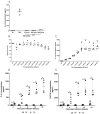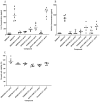Pseudomonas aeruginosa induces p38MAP kinase-dependent IL-6 and CXCL8 release from bronchial epithelial cells via a Syk kinase pathway
- PMID: 33524056
- PMCID: PMC7850485
- DOI: 10.1371/journal.pone.0246050
Pseudomonas aeruginosa induces p38MAP kinase-dependent IL-6 and CXCL8 release from bronchial epithelial cells via a Syk kinase pathway
Abstract
Pseudomonas aeruginosa (Pa) infection is a major cause of airway inflammation in immunocompromised and cystic fibrosis (CF) patients. Mitogen-activated protein (MAP) and tyrosine kinases are integral to inflammatory responses and are therefore potential targets for novel anti-inflammatory therapies. We have determined the involvement of specific kinases in Pa-induced inflammation. The effects of kinase inhibitors against p38MAPK, MEK 1/2, JNK 1/2, Syk or c-Src, a combination of a p38MAPK with Syk inhibitor, or a novel narrow spectrum kinase inhibitor (NSKI), were evaluated against the release of the proinflammatory cytokine/chemokine, IL-6 and CXCL8 from BEAS-2B and CFBE41o- epithelial cells by Pa. Effects of a Syk inhibitor against phosphorylation of the MAPKs were also evaluated. IL-6 and CXCL8 release by Pa were significantly inhibited by p38MAPK and Syk inhibitors (p<0.05). Phosphorylation of HSP27, but not ERK or JNK, was significantly inhibited by Syk kinase inhibition. A combination of p38MAPK and Syk inhibitors showed synergy against IL-6 and CXCL8 induction and an NSKI completely inhibited IL-6 and CXCL8 at low concentrations. Pa-induced inflammation is dependent on p38MAPK primarily, and Syk partially, which is upstream of p38MAPK. The NSKI suggests that inhibiting specific combinations of kinases is a potent potential therapy for Pa-induced inflammation.
Conflict of interest statement
I have read the journal’s policy and the authors of this manuscript have the following competing interests: Previously Matthew S. Coates was employed by Respivert Ltd. Garth W. Rapeport and Kazuhiro Ito were co-founders and employees of Respivert Ltd. During the period of the research G. W. Rapeport and K. Ito were co-founders and employees of Pulmocide Ltd. This does not alter our adherence to PLOS ONE policies on sharing data and materials.
Figures








Similar articles
-
Pseudomonas aeruginosa-derived flagellin stimulates IL-6 and IL-8 production in human bronchial epithelial cells: A potential mechanism for progression and exacerbation of COPD.Exp Lung Res. 2019 Oct;45(8):255-266. doi: 10.1080/01902148.2019.1665147. Epub 2019 Sep 13. Exp Lung Res. 2019. PMID: 31517562
-
Transcriptional regulation of lysophosphatidic acid-induced interleukin-8 expression and secretion by p38 MAPK and JNK in human bronchial epithelial cells.Biochem J. 2006 Feb 1;393(Pt 3):657-68. doi: 10.1042/BJ20050791. Biochem J. 2006. PMID: 16197369 Free PMC article.
-
IL-17-induced cytokine release in human bronchial epithelial cells in vitro: role of mitogen-activated protein (MAP) kinases.Br J Pharmacol. 2001 May;133(1):200-6. doi: 10.1038/sj.bjp.0704063. Br J Pharmacol. 2001. PMID: 11325811 Free PMC article.
-
Staphylococcus aureus Inhibits IL-8 Responses Induced by Pseudomonas aeruginosa in Airway Epithelial Cells.PLoS One. 2015 Sep 11;10(9):e0137753. doi: 10.1371/journal.pone.0137753. eCollection 2015. PLoS One. 2015. PMID: 26360879 Free PMC article.
-
Spleen Tyrosine Kinase as a Target Therapy for Pseudomonas aeruginosa Infection.J Innate Immun. 2018;10(4):255-263. doi: 10.1159/000489863. Epub 2018 Jun 20. J Innate Immun. 2018. PMID: 29925062 Free PMC article. Review.
Cited by
-
The ROCK-ezrin signaling pathway mediates LPS-induced cytokine production in pulmonary alveolar epithelial cells.Cell Commun Signal. 2022 May 12;20(1):65. doi: 10.1186/s12964-022-00879-3. Cell Commun Signal. 2022. PMID: 35551614 Free PMC article.
-
A novel in vitro model to study prolonged Pseudomonas aeruginosa infection in the cystic fibrosis bronchial epithelium.PLoS One. 2023 Jul 11;18(7):e0288002. doi: 10.1371/journal.pone.0288002. eCollection 2023. PLoS One. 2023. PMID: 37432929 Free PMC article.
-
Inhibition of Spleen Tyrosine Kinase Restores Glucocorticoid Sensitivity to Improve Steroid-Resistant Asthma.Front Pharmacol. 2022 May 5;13:885053. doi: 10.3389/fphar.2022.885053. eCollection 2022. Front Pharmacol. 2022. PMID: 35600871 Free PMC article.
-
C3aR plays both sides in regulating resistance to bacterial infections.PLoS Pathog. 2022 Aug 4;18(8):e1010657. doi: 10.1371/journal.ppat.1010657. eCollection 2022 Aug. PLoS Pathog. 2022. PMID: 35925892 Free PMC article. Review.
-
Genome-Wide RNAi Screening Identifies Novel Pathways/Genes Involved in Oxidative Stress and Repurposable Drugs to Preserve Cystic Fibrosis Airway Epithelial Cell Integrity.Antioxidants (Basel). 2021 Dec 2;10(12):1936. doi: 10.3390/antiox10121936. Antioxidants (Basel). 2021. PMID: 34943039 Free PMC article.
References
Publication types
MeSH terms
Substances
LinkOut - more resources
Full Text Sources
Other Literature Sources
Research Materials
Miscellaneous

